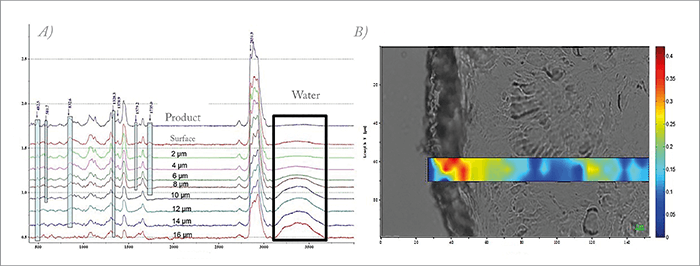Hyaluronic acid (HA) is a highly hydrophilic and remarkably viscoelastic molecule, able to retain up to 1000 times its weight in water – properties that make it a protective structure-stabilizing, shock-absorbing agent in the epidermis and dermis of skin. But the aging process brings with it a decrease in the skin’s natural HA content, which leads to loss of hydration, smoothness, and softness. In fact, its decline is even thought to cause wrinkles. Little wonder then that the molecule plays a starring role in cosmetics products and is name-dropped across beauty blogs and YouTube on a daily basis.
But how effective are HA-containing products at getting the beautifying acid where it is needed? A team of scientists at the University of Riems, France, set out to evaluate the depth of HA penetration and provide accurate localization of cosmetic actives in human skin, using samples from plastic surgical intervention (1). According to lead researcher Mohammed Essendoubi, several studies have demonstrated a significant improvement in skin hydration, wrinkle depth, and elasticity by using HA-based creams, but they have not shown HA penetration and localization in the skin layers – something his research managed to achieve. “Topical penetration of cosmetics molecules through the skin structures is one of the main issues in dermatology and cosmetology,” says Essendoubi. “Several conventional techniques, such as tape-stripping, are commonly used, but although widely accepted, these methods lack spatial accuracy and cannot be used for molecules where penetration is limited to the outermost layers of the skin.” The researchers used a Labram microspectrometer to assess the permeability of HA, and discovered that Raman imaging combined with chemometric methods are interesting alternative tools for cutaneous permeation tests. “As a laser-based spectroscopic technique, Raman detects the characteristic vibrational energy levels of a molecule. The spectra thereby constitute highly specific spectroscopic fingerprints,” Essendoubi says. “It represents an analytical, non-destructive, and dynamic method to improve the evaluation of the skin penetration of exogenous molecules with high accuracy and without particular preparation of the sample.”

Essendoubi says this is the first report to prove permeation and spatial distribution of HA with different molecular weight in human skin. “High molecular weights HA (1000-1400 kDa) hydrates the skin by forming a film on its surface and preventing water loss. In contrast, low molecular weight HA (20-300 kDa) can penetrate skin to protect and support epidermal hydration and to moisturize the stratum corneum continuously to assure high quality of the epidermal texture.” Will these discoveries filter down to more effective hydration in cosmetics or will the technique filter out to the study of other topical drugs? Only time will tell…
References
- M Essendoubi et al., “Human skin penetration of hyaluronic acid of different molecular weights as probed by Raman spectroscopy”, Skin Research and Technology, 22, 55-62 (2016)




